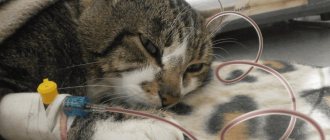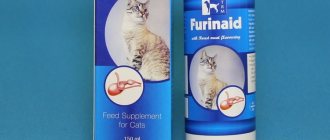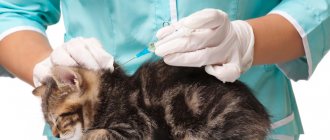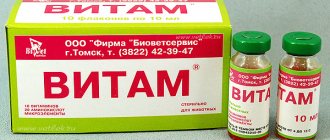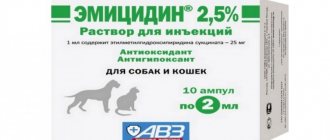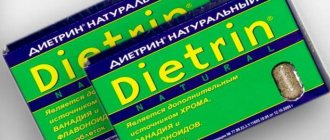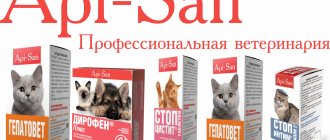The main component of the veterinary drug Dexafort for cats is synthetic hormones - analogues of cortisol. It is used to treat inflammatory diseases that arise for various reasons - from mechanical injuries to allergies. Since this medication is a hormonal drug that has a strong effect on the body, it is not recommended to use it without consulting a veterinarian.
general description
The medication is produced in the form of a white suspension, which is intended for injection. During long-term storage it may delaminate. This is considered normal, so you should not throw away the medicine if it separates. To package the suspension, transparent glass bottles with a capacity of 50 ml are used. For cat owners, in most cases it is not practical to purchase such a large container, since most of the medicine is thrown away, but the medicine is not sold in other containers. Each bottle is packaged in a cardboard box and comes with instructions, which must be read before using the suspension.
The main component of the anti-inflammatory drug, which determines its action, is dexamethasone. The composition of the medicinal liquid also includes auxiliary components that help preserve the properties of the active substance for a long time.
Note! In a closed bottle, the suspension can be stored for 3 years from the date of manufacture, but after opening it is suitable for use only for 28 days. Remember the day you opened the package or mark it with a sticker, since after the specified period the drug must be disposed of. It cannot be used to treat cats and other animals.
Release form of the drug, its composition
Dexafort is available in only one form - suspension. It has a white tint, there is no pronounced odor, and there may be a slight sediment. The medication is packaged in 50 ml bottles.
Expert opinion
Kuzmenko Olga Olegovna
Information about the expert
Ask a Question
The suspension can be used within two months after opening, after which the medicine must be disposed of.
The basis of the medication is dexamethasone (an analogue of cortisol of synthetic origin), or more precisely, two of its derivatives:
- one is absorbed for a long time, but has a long-lasting effect;
- the second one starts working immediately.
Thus, Dexafort quickly helps (after an hour the concentration of active components in the blood is maximum), while retaining its effect for 2 to 4 days. This indicator depends on the condition of the animal, its weight, and the individual characteristics of the body.
The composition also includes as auxiliary components:
- sodium salt of hydrochloric acid;
- sodium citrate;
- benzyl alcohol;
- water;
- cellulose ether and methanol.
Operating principle
Dexamethasone is a synthetic analogue of cortisol, a natural hormone found in the body of animals. In this regard, Dexafort has the following properties:
- relieves inflammation;
- eliminates swelling;
- stops the development of allergies.
When ingested, it inhibits the synthesis of substances involved in inflammatory processes. In addition, the drug stimulates the production of substances that have a pronounced anti-edematous ability. The drug suppresses the immune system and changes the dynamics of T-lymphocytes, and also affects their activity.
A distinctive feature of the anti-inflammatory drug is the combination of rapid action and long-lasting effect. This is achieved due to the fact that the active substance is contained in two different versions. Dexamethasone disodium phosphate is absorbed immediately after administration, so the effect of the drug begins almost instantly. But dexamethasone phenylpropionate is absorbed slowly, which ensures a long-lasting effect of the drug. At the same time, the drug is not addictive.
The drug reaches its maximum value in the blood after 1 hour. High concentrations can persist for up to 4 days. Another feature of the drug is its 100% bioavailability. In most cases, one injection is enough to get rid of inflammation.
Note! Despite its high effectiveness, Dexafort can be used after consultation with a veterinarian. If used incorrectly, it can have a negative impact on the functioning of internal organs and systems.
Characteristics of the drug Dexafort for cats
Dexafort is a glucocorticosteroid drug that helps eliminate the inflammatory process in a number of pathologies of an allergic and autoimmune nature. The medication is available in the form of a suspension, which is used for injection. The medicine contains the following components:
- dexamethasone phenylpropionate;
- dexamethasone sodium phosphate;
- sodium chloride;
- sodium citrate;
- benzyl alcohol;
- methylcellulose;
- water for injections.
Dexafort has anti-inflammatory and antiallergic effects
The drug has an immunosuppressive effect, eliminating the aggressive effect of T-lymphocytes on the body, which occurs in a number of autoimmune pathologies. The medication helps increase fat synthesis. It also affects carbohydrate and protein metabolism. While taking the medication, the absorption of calcium decreases, as a result of which, with long-term treatment, the risk of developing osteoporosis increases.
After administration of the suspension, swelling caused by the body's hypersensitivity to any substance is eliminated. The drug helps block the active production of prostaglandins, which are considered the main provocateurs of the inflammatory process. A special feature of the drug is its rapid action, compared to other drugs with similar effects on the body.
This medication can eliminate a number of anaphylactic reactions in animals, which can be fatal. The drug effectively relieves bronchospasm and severe swelling of the mucous membranes of the larynx and respiratory tract.
Indications for use
Typically, the medication is used to treat inflammation, including those of allergic or autoimmune origin. The instructions indicate that Dexafort for cats is prescribed for the treatment of the following diseases:
- with acute mastitis;
- for bronchial asthma;
- for joint diseases (arthritis, arthrosis, etc.);
- for allergic dermatitis;
- for eczema.
The drug is also effectively used to eliminate post-traumatic shock received during an accident, fall or other accident.
Dexafort, fl. 50 ml
Instructions for the use of Dexafort for the relief of inflammatory processes and diseases of allergic and autoimmune etiology in animals (Organization / Intervet International B.V., the Netherlands) I. General information 1. Dexafort for the relief of inflammatory processes and diseases of allergic and autoimmune etiology in animals. 2. Dexafort is a hormonal drug, in the form of a suspension, containing in 1 ml as active ingredients 2.67 mg of dexamethasone phenylpropionate and 1.32 mg of dexamethasone sodium phosphate, and as excipients - 4.0 mg of sodium chloride, 11.4 mg sodium citrate, 10.4 mg benzyl alcohol, 0.4 mg methylcellulose MH 50, water for injection up to 1 ml. 3. The drug is a white aqueous suspension; during long-term storage, it may separate, which is removed by shaking. 4. Dexafort is packaged in 50 ml glass bottles of appropriate capacity. The bottles are sealed with rubber stoppers and rolled up with aluminum caps. Each bottle of the medicinal product is labeled indicating the manufacturer and its address, the name and purpose of the medicinal product, the name and content of active ingredients, the date of manufacture and expiration date, storage conditions, batch number, the inscriptions “For animals”, “intramuscular and subcutaneous”, “sterile”, “shake before use”. Each bottle of the medicinal product is packaged in a cardboard box, which indicates the name and purpose of the medicinal product, the number of bottles, the name and content of the active substances, the date of manufacture and expiration date, storage conditions, the batch number, the inscriptions “For animals”, “intramuscular and subcutaneous” , “sterile”, “shake before use”. Instructions for use are included in each box. Bottles without labels, with a violation of the integrity of the packaging or closure, subjected to freezing, with a changed color, consistency, containing foreign impurities are subject to rejection and subsequent disposal. 5. The medicine is stored and transported with caution (list B), in original packaging in a dry place, protected from light and out of reach of children, at a temperature of 15 to 25 ° C. The shelf life of Dexafort, subject to storage conditions, is 60 months from the date of manufacture. After opening, the drug can be used for 8 weeks, subject to aseptic rules. Do not use after expiration date. II. Pharmacological properties 6. Dexamethasone, which is part of Dexafort, is a synthetic analogue of the glucocorticosteroid hormone of the adrenal cortex - cortisol and has a more pronounced glucocorticosteroid effect, has anti-inflammatory, decongestant, desensitizing and anti-allergic effects. The mechanism of action of the hormone is to block the release of inflammatory mediators by eosinophils, including prostaglandins, which potentiate the inflammatory process. Dexafort stimulates steroid receptors of lymphocytes, promoting the biosynthesis of lipocortins, which have anti-edematous activity. It inhibits the proliferation of lymphoid tissue and cellular immunity, and also disrupts the kinetics of T-lymphocytes, reducing their cytotoxic activity. B lymphocytes are more resistant to the action of glucocorticoids, but administration of the drug in high doses leads to a decrease in the concentration of immunoglobulins, which is associated with an initial increase in their catabolism and subsequent inhibition of synthesis. 7. Dexafort is characterized by its speed of action and duration of effect. After intramuscular administration, dexamethasone disodium phosphate immediately begins to be absorbed from the injection site. Dexamethasone phenylpropionate is absorbed more slowly and provides a long-lasting effect. The maximum concentration of dexamethasone in plasma is detected after 60 minutes. Therapeutic concentration in blood serum lasts 30–96 hours depending on the type of animal. Bioavailability after intramuscular administration is 100%. Biotransformation occurs in the liver and partly in fibroblasts involved in the metabolic process. Metabolites are mainly excreted through the liver and kidneys. III. Directions for use 8. Dexafort is used to relieve inflammatory processes and diseases of allergic and autoimmune etiology in animals (allergic dermatitis, eczema, post-traumatic edema, bronchial asthma, joint diseases, acute mastitis). 9. Dexafort is used once intramuscularly in the following doses: Horses, cattle - 10 ml. Foals, calves, sheep, goats, pigs - 1 - 3 ml. Dogs - 0.5 - 1 ml. Cats - 0.25 - 0.5 ml. If necessary, Dexafort is administered after 7 days. The drug is administered intramuscularly to cattle and horses, and intramuscularly or subcutaneously to dogs and cats. 10. With long-term use, Cushing's syndrome may occur, which causes redistribution of body fat, muscle weakness, weight loss and osteoporosis. Polyuria, polydipsia and polyphagia may occur. The use of corticosteroids in lactating cows may cause a short-term decrease in milk production. The use of corticosteroids to induce labor may cause a decrease in fetal viability, as well as an increase in the incidence of retained placenta. 11. Dexafort cannot be used simultaneously with vaccines due to the immunosuppressive effect of corticosteroids. 12. Dexafort is contraindicated in viral and fungal infections, diabetes, osteoporosis, hyperadrenocorticism, kidney disease, and heart failure. Use with caution in pregnant animals. Use in the last trimester of pregnancy is contraindicated, as this can lead to premature birth or abortion. 13. In the treatment of inflammation complicated by pathogenic and conditionally pathogenic bacterial microflora, Dexafort is prescribed only in combination with broad-spectrum antibacterial drugs. 14. Slaughter of cattle for meat is permitted after 48 days, horses - after 24 days. Cattle milk can be used for food after 5 days. In case of forced slaughter before the specified period, animal meat is used for the production of meat and bone meal. VI. Personal preventive measures 15. When working with Dexafort, you should follow the general rules of personal hygiene and safety precautions provided for when working with veterinary medicinal products. 16. All work with Dexafort must be carried out using special clothing and personal protective equipment (robe, hat, rubber gloves). 17. Upon completion of work, hands should be washed with warm water and soap.
How to use
Since Dexafort is a suspension that can separate, the contents of the bottle should be shaken well before use. Cats are given injections into the muscles or subcutaneously. Usually one injection is enough, as the drug retains its effect for several days. If the disease is advanced, a second injection may be required after 7 days. Only the doctor should determine the need for a second injection.
The dose of a hormonal anti-inflammatory drug is calculated taking into account the weight of the pet. For each kilogram of weight, only 0.05 ml of suspension is required. If the inflammatory process is complicated by pathogenic bacteria, Dexafort is used in conjunction with antibiotics. Usually the doctor selects a broad-spectrum antibiotic.
Does the drug have side effects?
If Dexafort is used as directed, the risk of side effects is minimal. You may see:
- increased appetite;
- thirst;
- as a result, excessive urination.
In rare cases, individual intolerance to the drug is observed, then analogues are selected. An overdose of dexamethasone in dogs can provoke the development of hyperadrenocorticism. Its symptoms:
- Apathy, weakness.
- Increased appetite.
- Weight loss.
- Thinning bones, porosity.
- Loss of muscle tone.
- Urinary incontinence.
- Symmetrical hair loss.
These are alarming signals, and if they are detected, you should immediately contact a veterinarian.
Restrictions
The highly effective drug has an impressive list of contraindications. It is not recommended to use Dexafort in the early stages of pregnancy, as it can cause congenital pathologies and anomalies. The medicine is strictly prohibited even in the third semester, as it can cause premature birth, during which the offspring may die.
You should not use a hormonal drug if you have the following diseases:
- for corneal ulcers;
- in cases of kidney dysfunction;
- for osteoporosis;
- with heart failure;
- for ulcers in the digestive system;
- in the presence of viral infections;
- for fungal diseases;
- with Cushing's syndrome (excessive production of cortisol by the adrenal glands).
Dexafort, like other glucocortisteroid drugs, is an antagonist (acts in the opposite way) of insulin, so it cannot be used for diabetes. It is not used together with vaccines. It suppresses the immune system, so the risk of complications increases. Some medications may reduce the effectiveness of the medication, so be sure to tell your doctor about any medications your pet is taking.
Note! Pets who are hypersensitive to an injection of an anti-inflammatory drug may develop anaphylactic shock. To prevent this, the cat is first given an anti-allergenic drug or injected with adrenaline.
Storage and transportation
Additional rules:
- storage and transportation must be carried out with caution;
- prevents exposure to sunlight;
- storage temperature 15-25 degrees Celsius;
- in a dry place;
- Protect from contact with children.
Shelf life:
- indicated on the packaging;
- no more than two months, subject to storage rules and regulations.
It is prohibited to use expired medication.
Recommended reading:
What to do if your cat has watery eyes - the best treatments
Cat injection
Side effects
If you use Dexafort for cats according to the instructions for use, it does not cause side effects. If used for a long time or the dose is calculated incorrectly, Cushing's syndrome may occur. The following symptoms may indicate this:
- excessive thirst;
- baldness;
- increased appetite;
- weight loss;
- urinary incontinence;
- muscle weakness.
Under the influence of the hormone, osteoporosis can develop. If you notice the above symptoms, you should consult a doctor for advice. After the examination, he will prescribe symptomatic therapy if necessary.
Instructions for use of the drug Dexafort for dogs
The dosage of Dexafort for dogs is determined by the veterinarian based on the condition of the animal and its weight. One injection contains 0.5–1 ml of medication. Most often the injection is given once, but if necessary it can be repeated after a few days.
Choose where to inject the suspension based on your preparation. An intramuscular injection is given in the upper thigh; this requires a little skill, as the needle can get into a nerve or vessel. The syringe is inserted at a right angle to a depth of 0.5–1.5 cm (depending on the size of the animal). If a drop of blood appears, wipe it off and inject in another place.
The second option is subcutaneous injection into the withers. Dogs do not have nerve endings in this area, so the owner can administer the medicine without special training. To do this, you need to pull the skin a little and insert the needle at an angle of 45 degrees. Then, without releasing the skin, pull out the syringe.
If you administer the injection yourself, do not forget that the syringe should be selected based on the size of the dog.
For inexperienced owners, the following tips will be useful:
- The injection site in dogs must be disinfected with an antiseptic.
- Shake the bottle of medicine before use.
- Air must be released from the syringe; to do this, you need to press on the piston until a drop of suspension appears at the tip of the needle.
The most popular question from dog owners is: “How long can Dexafort be used?” It is administered once to relieve severe symptoms. If necessary, the injection can be repeated after a week. In rare cases, systemic use is allowed, but always under medical supervision.
Owner reviews
Maria, owner of a 4-year-old cat:
“Our cat developed severe itching after her first heat. The doctor said that this was due to hormonal imbalances. We decided to sterilize, but this did not solve the problem. Over time, she again began to itch until she bled. Then we were prescribed Dexafort. At first, the effects of 2 injections were enough for six months, then courses had to be done more often. Now I inject the drug 3-4 times a year. The medicine is effective, already on the second day the cat stops completely itching.”
Irina, owner of the Abyssinian cat:
“Our cat’s first attack of bronchial asthma was a real shock for us. The doctor prescribed Dexafort. It works quickly and effectively. Within a couple of hours the cat begins to play and eat without problems. We now use other means for treatment, but this drug is always available in the first aid kit in case of asthma exacerbation.”
Valentina, owner of an 8-year-old cat:
“We used Dexafort to treat allergic dermatitis. The main symptoms went away within a day. The itching seemed to go away with my hand, although before the injection the Kid scratched his sides until they bled. A good remedy, but the doctor warned that it is hormonal and should not be used often. And the price is very steep. It’s a shame that we had to throw away almost an entire bottle of medicine, since it cannot be stored for a long time.”
Cost and analogues of Dexafort
The drug is produced by a Dutch company and has a high cost. On average, a 50 ml bottle will cost around 1000 rubles.
Be sure to read:
Suprastin for cats: when prescribed, dosage, how often to give, is it possible during estrus, contraindications
The medicine is packaged in a green or blue box. This is due to the fact that the manufacturer has changed the color policy, and medicines from new and old batches are on sale. There are no differences in the medicine itself.
The main analogue of the drug is Cortexon Retard injection.
